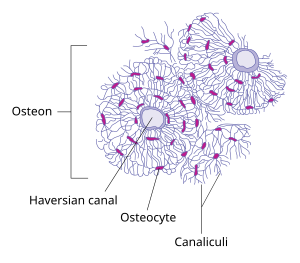Bone canaliculi are microscopic canals between the lacunae of ossified bone. The radiating processes of the osteocytes (called filopodia) project into these canals. These cytoplasmic processes are joined together by gap junctions. Osteocytes do not entirely fill up the canaliculi. The remaining space is known as the periosteocytic space, which is filled with periosteocytic fluid. This fluid contains substances too large to be transported through the gap junctions that connect the osteocytes.
| Canaliculi in bone osteons | |
|---|---|
 Diagram of cross-section of bone osteons showing osteocytes and interconnecting canaliculi. | |
| Identifiers | |
| TH | H2.00.03.7.00003 |
| FMA | 61923 |
| Anatomical terminology | |
In cartilage, the lacunae and hence, the chondrocytes, are isolated from each other. Materials picked up by osteocytes adjacent to blood vessels are distributed throughout the bone matrix via the canaliculi.
Diameter of canaliculi in human bone is approximately 200 to 900 nm.[1] In bovine tibia diameter of canaliculi was found to vary from 155 to 844 nm (average 426 nm).[2] In mice humeri it varies from 80 to 710 nm (average 259 nm), while diameter of osteocytic processes varies from 50 to 410 nm (average 104 nm).[3]
Dental canaliculi
editThe dental canaliculi (sometimes called dentinal tubules) are the blood supply of a tooth.[4] Odontoblast process run in the canaliculi that transverse the dentin layer and are referred as dentinal tubules.[5] The number and size of the canaliculi decrease as the tubules move away from the pulp and toward the enamel or cementum.
See also
editReferences
edit- ^ Hesse, B., Varga, P., Langer, M., Pacureanu, A., Schrof, S., Männicke, N.; et al. (2015). "Canalicular Network Morphology Is the Major Determinant of the Spatial Distribution of Mass Density in Human Bone Tissue: Evidence by Means of Synchrotron Radiation Phase-Contrast nano-CT". Journal of Bone and Mineral Research. 30 (2): 346–356. doi:10.1002/jbmr.2324. PMID 25130720.
{{cite journal}}: Explicit use of et al. in:|author=(help)CS1 maint: multiple names: authors list (link) - ^ Lin, Y., & Xu, S. (2010). "AFM analysis of the lacunar-canalicular network in demineralized compact bone". Journal of Microscopy. 241 (3): 291–302. doi:10.1111/j.1365-2818.2010.03431.x. PMID 21118225.
{{cite journal}}: CS1 maint: multiple names: authors list (link) - ^ You, L.-D., Weinbaum, S., Cowin, S. C., & Schaffler, M. B. (2004). "Ultrastructure of the osteocyte process and its pericellular matrix". The Anatomical Record. 278A (2): 505–513. doi:10.1002/ar.a.20050. PMID 15164337.
{{cite journal}}: CS1 maint: multiple names: authors list (link) - ^ "Magitot on the Development and Structure of the Human Teeth". The American Journal of Dental Science. 9 (4): 449–490. October 1859. PMC 6087359. PMID 30751935.
- ^ Gray, Henry (1913). Anatomy, Descriptive and Applied. Lea & Febiger. pp. 1119–1121.